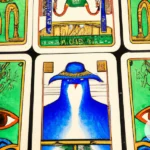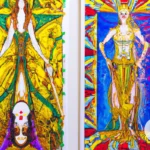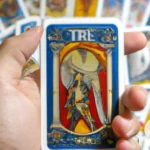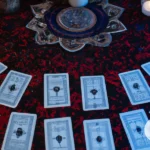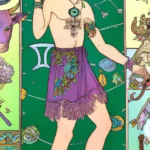Have you ever wondered about the significance of astrological houses and their connection to tarot cards? The universe is vast and mysterious, and there are various ways of interpreting its secrets. Astrological houses serve as a blueprint for one’s life experiences, while tarot cards act as a tool for divination and self-reflection. But how do these two practices intersect, and what can tarot cards teach us about the different houses? In this article, we delve into the role of tarot cards in understanding houses and their significance in astrology. So grab your deck, and let’s explore the mysteries of the universe together.
Part 1: Understanding Astrological Houses
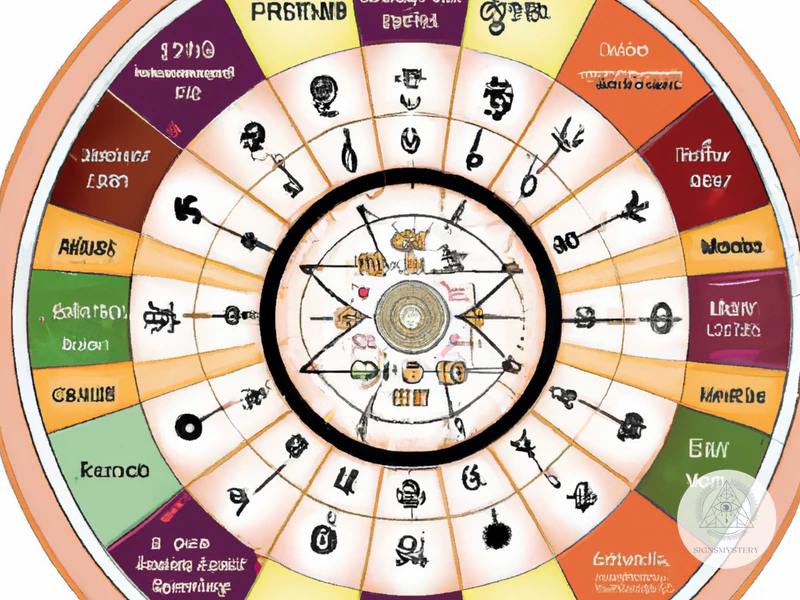
Understanding astrological houses is an important aspect of astrology as they form the basis of a horoscope. Each house in a horoscope represents a different aspect of our lives and understanding the significance of each house can provide valuable insights into our personality, behavior, and life events. In this section, we will explore what astrological houses are, their significance, and how they can be interpreted using tarot cards. If you’re interested in exploring the connection between tarot and astrology further, you can check out our guide on using tarot for astrological guidance.
1.1 What are Astrological Houses?
Astrological Houses are a fundamental feature of astrology. These are twelve sectors that determine how the celestial energies influence an individual’s life. Each of these houses represents a particular area of life, and their significance depends on the planetary positions at the time of birth. The Houses represent the various areas of life wherein the native experiences the effects of his actions, thoughts, and decisions. They are known as the domains of human existence and represent different facets of one’s personality and life.
The First House or the Ascendant represents the individual’s personality traits and appearance. This house is ruled by Aries and is all about the native’s physical appearance, energy, behavior, and demeanor. The Second House is associated with possessions and money matters, while the Third House represents communication, learning, and the immediate environment. The Fourth House governs the individual’s home, family life, and emotional foundation. The Fifth House is associated with creativity, self-expression, love affairs, and children. The sixth house is about health, service, work, and routines. The seventh house is all about partnerships and relationships, including business partnerships and marriage. The eighth house represents shared resources, death, and rebirth, and the Ninth House represents philosophical and spiritual matters.
The Tenth House is related to career, social status, and reputation. It’s a house of achievement and mastery, representing how the individual relates to the outer world. The Eleventh House represents social networks, friendships, and aspirations, whereas the Twelfth House signifies transcendence, spirituality, and secret enemies. Each of the houses has its own unique characteristics, and the position of the houses can give insights into different aspects of an individual’s life and personality.
Whether you’re interested in astrology, tarot, or both, understanding the meaning of each astrological house can be extremely helpful in gaining a deeper understanding of yourself and others. Tarot Cards can give additional insights into astrological houses and help to clarify their significance. To read about Tarot and Astrology, check out this article: Tarot vs Astrology.
1.2 The Significance of Each House
Understanding the significance of each house is crucial to interpreting an individual’s natal chart. There are twelve astrological houses, each with a distinct meaning and energy. Here is a breakdown of each house and its significance:
| House | Significance |
|---|---|
| First House (Ascendant) | The first house represents the individual’s personality, self-image, and physical appearance. It is also associated with new beginnings and how one presents themselves to the world. |
| Second House | The second house relates to money, possessions, and values. It is associated with one’s financial stability and how they view their own self-worth. |
| Third House | The third house relates to communication, siblings, and early education. It is associated with one’s mindset and how they communicate with others. |
| Fourth House (IC) | The fourth house represents home, family, and roots. It is also associated with one’s emotional foundation and sense of security. |
| Fifth House | The fifth house relates to creativity, pleasure, and children. It is associated with both romantic and platonic relationships, as well as personal hobbies and interests. |
| Sixth House | The sixth house represents work, service, and health. It is associated with one’s daily routines, work ethic, and physical health. |
| Seventh House (Descendant) | The seventh house relates to partnerships, both romantic and business-related. It is associated with how one relates to others and how they handle conflicts. |
| Eighth House | The eighth house represents death, transformation, and shared resources. It is associated with intimate relationships, inheritances, and hidden fears or desires. |
| Ninth House | The ninth house represents philosophy, higher education, and travel. It is associated with one’s beliefs and values, as well as their curiosity and desire for adventure. |
| Tenth House (MC) | The tenth house represents career, status, and public reputation. It is associated with one’s aspirations and how they are viewed by society. |
| Eleventh House | The eleventh house relates to friendship, social groups, and aspirations. It is associated with one’s contribution to society and their role within a larger community. |
| Twelfth House | The twelfth house represents retreat, solitude, and self-undoing. It is associated with one’s internal struggles and subconscious fears, as well as their capacity for spirituality and compassion. |
Understanding the significance of each house is essential in interpreting astrological charts, and incorporating tarot can provide further insight. By using tarot cards in conjunction with astrological houses, one can gain deeper understanding of the individual’s personality, life purpose and action plan. In the next section, we will explore the connection between tarot cards and houses.
Part 2: Tarot Cards and Houses
As we discussed in the previous section, Astrological Houses play a crucial role in understanding an individual’s personality, behavior, and destiny. Tarot cards, on the other hand, have been used for centuries as a tool for divination and gaining insights. In this section, we will explore the correlation between Tarot and Astrological Houses and how Tarot cards can be used to enhance our understanding of the Houses. We will also delve into the significance of Court Cards, Major Arcana, and Minor Arcana in understanding the Houses. By the end of this section, you will have a better understanding of how Tarot cards can be used as a tool for Astrological insight.
To learn more about how Tarot can enrich our understanding of different Zodiac signs, check out Tarot and the Zodiac Signs.
2.1 Introduction to Tarot Cards
Tarot cards are a divination tool consisting of a set of 78 cards divided into two main categories: the Major Arcana and the Minor Arcana. The cards are rich in symbolism and can be used for gaining insight into various aspects of life, including astrology. The tarot has been used in this way for centuries and continues to be a popular tool for astrologers today.
Major Arcana: The Major Arcana consists of 22 cards which represent important life lessons and milestones. These cards can be thought of as archetypes, each having a unique energy and meaning. Some of the cards in the Major Arcana are The Fool, The Magician, The High Priestess, The Empress, The Emperor, The Hierophant, The Lovers, The Chariot, Strength, The Hermit, The Wheel of Fortune, Justice, The Hanged Man, Death, Temperance, The Devil, The Tower, The Star, The Moon, The Sun, Judgement, and The World.
Minor Arcana: The Minor Arcana consists of 56 cards divided into four suits: Wands, Cups, Swords, and Pentacles. Each suit has 14 cards with their unique symbolism and meaning. The Minor Arcana represents everyday events and experiences and can provide more detailed information about a situation. The cards in each suit are numbered from Ace to 10, with four court cards: the Page, Knight, Queen, and King.
The tarot is often used in conjunction with astrology to provide further insight into a person’s life. By exploring the interactions between the tarot cards and the astrological houses, an individual can gain more insight into their strengths, weaknesses, and life purpose. In the next section, we will explore the correlation between tarot cards and astrological houses in more detail.
To learn more about how tarot cards can be used in astrology, check out these resources:
- Tarot Spreads for Astrology
- Tarot and Ruling Planet Influence
- Astro Tarot Transits
- Tarot and Planetary Retrogrades
- Tarot Cards and Lunar Cycles in Astrology
2.2 Correlating Tarot Cards with Houses
Tarot cards can be used to gain deeper insights into the twelve astrological houses. Each house has a unique energetic vibration, and correlating tarot cards with these houses can help us understand the energies at play. Here are the tarot cards that correspond with each of the astrological houses:
- The First House: The Magician
- The Second House: The Empress
- The Third House: The Lovers
- The Fourth House: The Emperor
- The Fifth House: The Sun
- The Sixth House: The Hermit
- The Seventh House: Justice
- The Eighth House: Death
- The Ninth House: The Wheel of Fortune
- The Tenth House: The World
- The Eleventh House: The Star
- The Twelfth House: The Moon
Each of these tarot cards has a corresponding archetype and energy that can help us understand the themes and lessons of each house. For example, when The Magician appears in a tarot reading related to the first house, it can indicate the need to take control of one’s life and to use creativity and communication to manifest one’s desires. Similarly, when The Empress appears in a reading related to the second house, it can represent abundance, fertility, and the nurturing of one’s resources.
It’s worth noting that these correlations are not fixed and can vary depending on the nuances of each tarot card and house. Nonetheless, by working with these associations and paying attention to the insights that emerge, we can deepen our understanding of astrology and tarot as well as our own psyche.
2.3 Court Cards and Houses
One important aspect to consider when using tarot cards to understand astrological houses is the relationship between the court cards and houses. Court cards in tarot represent different personalities and characteristics, and they can also be used to represent actual people or situations in a reading.
To better understand the correlation between court cards and houses, take a look at the following table:
| Court Card | House |
|---|---|
| Page | 1st House |
| Knight | 2nd House |
| Queen | 3rd House |
| King | 4th House |
Each court card is associated with a different astrological house, based on the qualities they represent. The page, for example, corresponds with the 1st house, which represents self-discovery and self-identity. The knight, on the other hand, is linked with the 2nd house, which deals with resources, material possessions, and financial security. The queen is associated with the 3rd house, which governs communication, relationships, and learning. Ultimately, the king is related to the 4th house, which represents the home, family and childhood.
Understanding the relationship between court cards and houses can be extremely beneficial when interpreting a tarot reading. It can help provide insight into the individual’s personality traits, as well as identify potential future events or situations that may arise.
The correlation between court cards and astrological houses is a critical component of using tarot cards to understand the significance of each house. By keeping this relationship in mind, readers can more easily interpret tarot spreads and provide more accurate and insightful readings.
2.4 Major Arcana and Houses
The Major Arcana is composed of 22 cards that represent the major events and influences in an individual’s life. Each card corresponds to a specific archetype and symbolizes a particular phase of human development. In tarot reading, the Major Arcana can reveal important insights about an individual’s personality and life path.
The Major Arcana cards can also offer valuable information about the astrological houses. Each of the Major Arcana cards is associated with a specific astrological sign or planet, which in turn is connected to one of the twelve houses. The table below summarizes the relationships between the Major Arcana cards and the astrological houses they correspond to:
| Major Arcana Card | Astrological House |
|---|---|
| The Fool | Uranus/House 11 |
| The Magician | Mercury/House 1 |
| The High Priestess | Moon/House 4 |
| The Empress | Venus/House 2 |
| The Emperor | Aries/House 1 |
| The Hierophant | Taurus/House 2 |
| The Lovers | Gemini/House 3 |
| The Chariot | Cancer/House 4 |
| Strength | Leo/House 5 |
| The Hermit | Virgo/House 6 |
| Wheel of Fortune | Jupiter/House 9 |
| Justice | Libra/House 7 |
| The Hanged Man | Neptune/House 12 |
| Death | Scorpio/House 8 |
| Temperance | Sagittarius/House 9 |
| The Devil | Capricorn/House 10 |
| The Tower | Mars/House 1 |
| The Star | Aquarius/House 11 |
| The Moon | Pisces/House 12 |
| The Sun | Sun/House 5 |
| Judgement | Pluto/House 8 |
| The World | Saturn/House 10 |
By understanding the relationship between the Major Arcana cards and the astrological houses, a tarot card reader can gain an even deeper insight into an individual’s life path and personality. The correspondences between the two systems can offer valuable information about an individual’s strengths, challenges, and potential for growth.
2.5 Minor Arcana and Houses
The minor arcana cards in the tarot deck are divided into four suits – cups, swords, wands, and pentacles. Each suit has 14 cards, which are numbered from Ace to Ten, and four face cards, namely the Page, Knight, Queen, and King. These cards correspond to the 12 astrological houses in a unique way, which helps in understanding the correlation between tarot and astrology.
The Cups Suit and Astrological Houses
The Cups suit is associated with emotions, feelings, and relationships. The Ace of Cups represents new beginnings and emotional fulfillment, which corresponds to the 4th house of home and family. The Two of Cups symbolizes partnership and love, which is associated with the 7th house of marriage and partnerships. The Three of Cups stands for celebration and community, which corresponds to the 11th house of social networks and friendships. The remaining cards in this suit also have a unique connection with the astrological houses.
The Swords Suit and Astrological Houses
The Swords suit is associated with the mental realm such as thoughts, logic, and decision-making. The Ace of Swords represents clarity and new ideas, which is associated with the 3rd house of communication and learning. The Two of Swords symbolizes balance and decision-making, which corresponds to the 2nd house of self-worth and values. The Ten of Swords is associated with endings and letting go, which is linked to the 12th house of spiritual growth and healing.
The Wands Suit and Astrological Houses
The Wands suit is associated with energy, creativity, and passion. The Ace of Wands represents new beginnings and opportunity, which corresponds to the 1st house of self and identity. The Three of Wands represents expansion and growth, which is associated with the 9th house of philosophy and higher learning. The Ten of Wands symbolizes exhaustion and responsibility, which is linked to the 6th house of work and service.
The Pentacles Suit and Astrological Houses
The Pentacles suit is associated
Subscribe to Our Newsletter
Sign up to receive the latest news and updates.
Understanding the correlation between the minor arcana cards and astrological houses can help gain insight into different aspects of our lives. It can provide guidance and support in decision-making and self-discovery. It is essential to understand the meaning of each card and its corresponding astrological house to effectively use tarot cards for self-reflection and growth.
Part 3: How to Use Tarot Cards in Understanding Houses
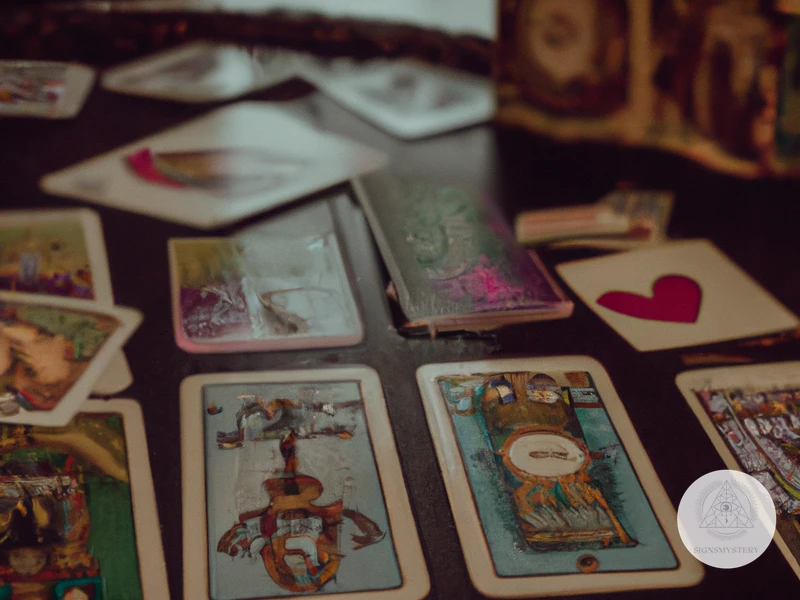
As we have discussed earlier how Tarot cards can be used to gain insights into Astrological houses, it’s now time to delve into the practical aspect of using Tarot cards to understand houses. So, if you are intrigued to explore the power of Tarot cards in interpreting different houses in Astrology, then keep reading! In this section, we will discuss a step-by-step process to use Tarot cards in understanding houses along with some sample Tarot spreads to get you started. Let’s get started with the magic of Tarot cards!
3.1 Steps to Use Tarot Cards in Understanding Houses
Using tarot cards can be a valuable tool in understanding astrological houses. Here are some steps to follow when using tarot cards in understanding houses:
Step 1: Begin by determining which house or houses you would like to explore. This can be based on your personal astrological chart or simply an area of your life you would like to focus on.
Step 2: Select a tarot card that represents the general energy or theme of the chosen house. This can be done by looking at traditional associations of the card or by following your intuition.
Step 3: Lay out the tarot cards in a spread that corresponds to the chosen house. For example, if exploring the 4th house of home and family, lay out the cards in a layout that resembles a house or with positions representing each family member.
Step 4: Interpret the cards in the context of the house being explored. Consider the traditional meanings of the cards as well as any personal associations or intuitive insights that come up.
Step 5: Use the insights gained from the tarot reading to gain a deeper understanding of the chosen house and how it relates to your life. This can include identifying areas of strength, areas for growth, and potential challenges to overcome.
Remember that tarot cards are a tool for self-reflection and exploration, and should be used as such. Although they can provide insights and guidance, ultimately it is up to us to take action and make positive changes in our lives.
Part 4: Sample Tarot Spreads for Exploring Houses
Are you ready to take your understanding of tarot cards and astrological houses to the next level? Look no further than this section, where we will delve into sample tarot spreads that can help you explore the significance of each house. By using tarot cards to gain insight into the different areas of life represented by the houses, you can better understand how they influence your individual astrology chart. Whether you are a seasoned tarot reader or just starting out, these spreads offer a unique and illuminating way to deepen your astrological knowledge. So grab your deck and get ready to explore the houses in a whole new way.
4.1 Sample Tarot Spreads
When it comes to exploring astrology through tarot, using specific tarot spreads can be helpful in gaining deeper insight into the different houses. Here are some sample tarot spreads that can be used to explore the different houses:
| Tarot Spread | Description |
|---|---|
| The House Spread | This spread focuses on each of the 12 houses and their corresponding astrological signs. The cards drawn can provide insight into the themes, energies, and challenges associated with each house. |
| The Four Elements Spread | Based on the four elements in astrology (fire, earth, air, water), this spread can provide insight into the influences of each element in your life and how they relate to your astrological houses. |
| The Astrological Wheel Spread | This spread is similar to The House Spread but places the cards in the layout of the astrological wheel. It can provide a visual representation of the different houses and their corresponding energies. |
| The Planetary Spread | Based on the planets in astrology, this spread can provide insight into the planetary influences in your life and how they relate to specific houses in your chart. |
These tarot spreads can be used in conjunction with knowledge of astrology and tarot to gain a deeper understanding of the energies and themes associated with the different houses. By interpreting the tarot cards drawn in each spread, one can gain insight into the challenges, lessons, and opportunities associated with each house in their astrological chart.
Conclusion
In conclusion, the use of Tarot cards in understanding astrology houses can greatly enhance one’s understanding of their personal astrological chart. It provides a holistic approach to interpreting the various aspects of life that are represented in each house. By incorporating Tarot cards into the interpretation process, one can gain deeper insights into the meaning and significance of each house and the aspects of life it represents.
The Tarot cards provide a visual representation of the energy and symbolism associated with each house. They allow us to tap into our intuition and connect with our subconscious, which can reveal insights and guidance that we may not have otherwise discovered. By using Tarot cards in combination with astrology, we can gain a more comprehensive understanding of our lives and the broader universe around us.
It is important to note that while Tarot cards can provide valuable insights and guidance, they should not be relied on solely for making important life decisions. It is essential to consider other factors and use discernment when interpreting Tarot readings. Additionally, it is recommended to consult with an experienced astrologer or Tarot reader who can provide guidance and support in interpreting Tarot readings and understanding astrological charts.
Overall, the use of Tarot cards in understanding astrology houses can be a powerful tool for gaining deeper insights into our lives and the world around us. Through a thoughtful and intuitive approach, we can use Tarot cards to explore the various aspects of our lives and gain a greater understanding of our place in the universe.
Frequently Asked Questions
1. Can tarot cards accurately predict the future?
No, tarot cards are not meant to predict the future with absolute certainty. They are a tool that can be used to gain insight into one’s thoughts, emotions, and actions, which can then help inform life decisions.
2. What is the difference between the Major and Minor Arcana in tarot cards?
The Major Arcana cards represent major life events or archetypes, such as the Fool or the High Priestess. The Minor Arcana cards represent everyday events or situations, such as a job offer or a disagreement with a friend.
3. Are tarot cards associated with a particular religion or belief system?
No, tarot cards can be used by people of any religious or spiritual background. They are a tool for personal growth and self-awareness, rather than a religious practice.
4. What is the significance of each tarot card’s imagery?
The imagery on each tarot card is rich with symbolism and represents different concepts or emotions. For example, the Tower card often depicts a crumbling building, which can represent sudden upheaval or chaos in one’s life.
5. Can tarot cards be used for group readings?
Yes, tarot cards can be used for group readings. The tarot reader can interpret the cards based on the collective energy and dynamic of the group.
6. Is it necessary to be a gifted psychic to read tarot cards?
No, anyone can learn how to read tarot cards with practice and dedication. It is a skill that can be honed over time.
7. Can a single tarot reading provide all the answers to life’s questions?
No, a single tarot reading cannot provide all the answers to life’s questions. Tarot readings can provide insight and guidance, but ultimately it is up to the individual to make their own decisions.
8. Is it possible to reverse a negative tarot card reading?
Yes, a negative tarot card reading can be seen as an opportunity for growth and change. The tarot reader can work with the individual to identify areas where they can make positive changes in their life.
9. Can tarot card readings be done over the phone or online?
Yes, tarot card readings can be done over the phone or online through video chat. The energy and connection between the individual and tarot reader can still be established in these formats.
10. What should someone do if they don’t understand a tarot card reading?
If the individual is confused about a tarot card reading, they should ask the tarot reader for clarification or explanation. It is important to feel comfortable and informed during the reading process.



